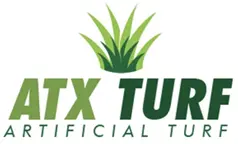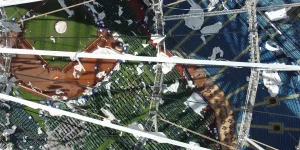Extreme Weather Vs Turf & Netting: What Exactly Happens & What To Do About It
Published Nov 6, 2024
This post is 0% AI Generated.
Recent extreme weather events in the US have been on the minds of many ATXTurf customers…..AND Winter is Coming.
Tornadoes in Oklahoma? Blizzards in the northeast? Flooding on the coast? Hurricanes in…..the mountains??
Repairing Batting Cages After Heavy Storms is the more common concern for most of our customers, but this article may help in more extreme situations, as well.
This article describes what happens to turf and netting in:
1. Heavy WInd
2. Rain & Flooding
3. Snow & Ice
4. Sun & Heat
And What To Do About It…..
1. Heavy Wind
Whether it’s heavy storms, tornadoes or hurricanes, WIND is typically the culprit of turf and netting damage, followed by water/flooding.
Heavy, high winds can catch the net and compromise the structure and turn the net into a mangled mess. Wind can get under improperly secured turf and lift entire corners of fields and batting cages.
What To Do About it?
Netting:
If your insurance plan doesn’t simply replace the materials and installation, the best thing to do in these cases is to simply take the net down instead of trying to straighten it out while hanging. A scissor lift or lift might be necessary for taller structures. Unclip it, wherever it is still clipped. If the net doesn’t have too many tears, it can be straightened out and reclipped in the order it was originally clipped.
If there are just a few small holes, they can be patched or zip-tied. If there are large tears and holes, you are better off getting a new net. The cables may also need to be re-hung
Turf:
Tornadoes and heavy winds can do a number on turf. Especially on older turf, that is thinner and lighter from wear. A 7 year old high school football field for example, can be .5 inch thick and weigh only 2 lbs per square compared to newer, 2 inch thick, 5 – 8 lb per square foot fields. These are particularly susceptible. Once the wind and water get under it, it can move and “twist” creating wrinkles that are very difficult to ever get back. The original integrity is almost impossible to regain. Entire sections or rolls, will have to be replaced, if not the entire area or field.
For single backyard batting cages, the turf may be lifted or folded over if it wasn’t secured very well in the first place. BUT, since its a single roll, it can typically be re-laid and re-secured as there are rarely seams or logos to deal with.
2. Rain & Flooding
Rubber infill fields suffer from “migration” in heavy rain and flooding. Rubber pellets float, poor drainage and flooding can cause large amounts of infill to migrate and settle in piles on fields as seen above.
If the turf has the appropriate sub-base and drainage, water should continue to drain straight through the turf and away. However, you may be left with wrinkles and separated seams.
What To Do About it: In mild cases a simple power broom may re-level it, or a “street sweeper” style brush may be necessary for larger jobs. In small areas of seam separation, a bit of turf glue may re-seal it.
The turf itself can lift and wrinkle. In mild cases, the wrinkles may be able to be kicked out with knee kickers or carpet stretchers. Larger wrinkles spanning multiple rolls may need to be replaced, as it will be difficult to re-seam the original pieces. Wrinkles on logos and numbers are very difficult to repair and may simply need to be redone. There are a lot of variables here with multiple pieces of turf intersecting, as seen in the blue and orange logo above. The glue and seam fabric on the back of the cut-ins are difficult to ever get flat again and will be tripping hazards.
Single Batting Cage Turf Rolls are fairly easy to repair as single cages don’t have seams that have to be redone. In most cases, these can be laid back down and simply re-secured. Perhaps its a good idea to use more stakes or more glue than previously.
The Sub-Base
Heavy rains and flooding can shift and make the sub-base uneven, so that may need to be re-leveled and compacted before laying the turf back over it.
Make sure to use the proper sub base materials. Without proper air flow, wet turf can stink and even become moldy over time.
3. Snow & Ice
Snow & Ice, by themselves, are not damaging to turf and netting. It simply melts and drains through the turf or off the netting material.
Netting structure, however, can be compromised, much like trees and branches, when ice accumulates on cables and structures, it can result in sagging. But it does not impact the materials themselves. One school of thought says nylon netting can absorb more water than poly (hdpe) netting if not properly coated in oil.
What To Do About it: You can knock the snow and ice off, much like folks do on their roofs before it accumulates too much. Snow can be snow-plowed off of turf, but VERY carefully. Read the ATXTurf article on Turf in the Winter.
4. Sun
Extreme Sun and heat CAN accelerate wear, as is the case with any material. Turf color can fade faster and netting can become more brittle in extreme continued heat, such as in the southwest. Dry air, in particular, can cause static on the turf but there are remedies for this. Sun, of course, can also elevate the temperature of turf and be hot on the feet, which you can read more about here. Read the ATXTurf article on Static & Turf for more details.
We know investing thousands of dollars is not easy for many parents, schools and booster clubs. It’s a big decision which considers many angles and risks. We hope this helps.
As usual feel free to reach to out ATXTurf with any further questions.







0 Comments